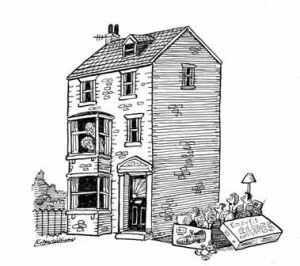Colin Wiles, an independent housing consultant and social housing expert, analyses what is wrong with the housing market today, and argues for reforms that embrace more social housing
Nowhere is the widening wealth gap between old and young more pronounced than in housing.
The latest English Housing Survey shows that the situation is worsening. Owner-occupation is going down, private renting has increased, and a whole generation of younger people can see the prospect of owning their own home retreating into the far distance.
Priced out into renting
Of the 22.6 million households in England, 63% are owner-occupiers, down from a peak of 71% in 2003, but for the first time the proportion of outright owners exceeds the proportion of those buying with a mortgage. It is younger, priced-out buyers who have lost out. The private rented sector (19%) is now larger than the social rented sector (17%) and young households aged 25–34 are more likely to rent than to buy. 48% of all households in this age group now rent privately, a figure that has more than doubled since 2003.
Over the same period, owner-occupation among this younger age-group fell from 59% to 36%. So the last decade has seen a dramatic shift in the fortunes of young people at the expense of elderly homeowners.
In the 1960s, the average house cost little more than three times the average income in England. Today, it is seven times average incomes.
The primary cause for this crisis is the decline of housebuilding. In 1968 we built 352,000 homes in England and 149,000 of them were built by councils and housing associations. Current household projections indicate that we need to build 250,000 homes a year, yet over the past five years total output has hovered around the 110,000 mark, and a deficit of over one million homes has accrued.
A call for government action
So what’s to be done? The solution rests with the political class. In a recent Ipsos MORI poll, 86% of MPs disagreed with the statement that “there isn’t much that British governments can do to deal with Britain’s housing problem.’’ So they understand that they have the power to solve the crisis, even though they appear to have done very little about it in recent years.
To be fair to politicians, they are caught in the crossfire between vocal Nimby protestors (who are more likely to be elderly homeowners than not) and those who are desperate for homes. In truth, it is those who oppose new homes who tend to be more influential.
This level of political inaction manifests itself in various ways.
First, the amount of investment in affordable housing has declined considerably. I mentioned above that 149,000 homes were built by councils and housing associations in 1968. Last year that figure had dropped to 25,000. This reliance upon the market to meet housing needs has been disastrous for growing numbers of people. As rents have risen broadly in line with house prices, so more and more and more people have had to turn to Housing Benefits for help with their housing costs.
We invest little more than £1 billion a year in affordable housing, yet the Housing Benefit bill is £25 billion and rising, and 40% of it goes to private sector tenants. A significant proportion of the 2 million homes that were sold under the Right to Buy are now let privately and many of these tenants rely upon Housing Benefit to get by.
Second, the release of land has been inadequate. The scrapping of national and regional housing targets has led to a free-for-all among local authorities, who are struggling to draw up local development plans. Councils often find themselves the target of local Nimby protestors who see no need for new homes in their district, or at least not in their locality. Councils are failing to co-operate with each other, especially where councils with plenty of land adjoin those that are landlocked. As a result, land prices have increased dramatically, accounting for two-thirds of the price of a new home in many areas. We need a rational and objective planning system that includes a new programme of garden cities and new towns.
Third, the housebuilding industry has become a semi-cartel and needs to be reformed. There has been a decline of small firms and a rash of mergers at the top end. The ten largest housebuilders now account for around half of all output. These firms are more interested in preserving their profit margins than building volumes of new homes. Over the past fifty years house builders have rarely turned out more than 150,000 homes a year. In economic terms its output is inelastic, that is, it does not respond to the normal market signals of supply and demand that would see more cars, for example, being produced if demand increased.
Finally, as a founding member of SHOUT – the Campaign for Social Housing – I believe that this inability of the private sector to respond to both housing demand and housing need sends out a clear message that we need to add significant number of public-funded homes into the mix. It is only by investing in social rented homes – 100,000 a year is the figure quoted in our manifesto – that we can make a real difference. It would help to lower rents and reduce the Housing Benefit bill; it would ease pressure on house prices and it would help elderly owner-occupiers and under-occupiers to move into more suitable accommodation. Above all, it would inject a much-needed dose of fairness into our housing system.
